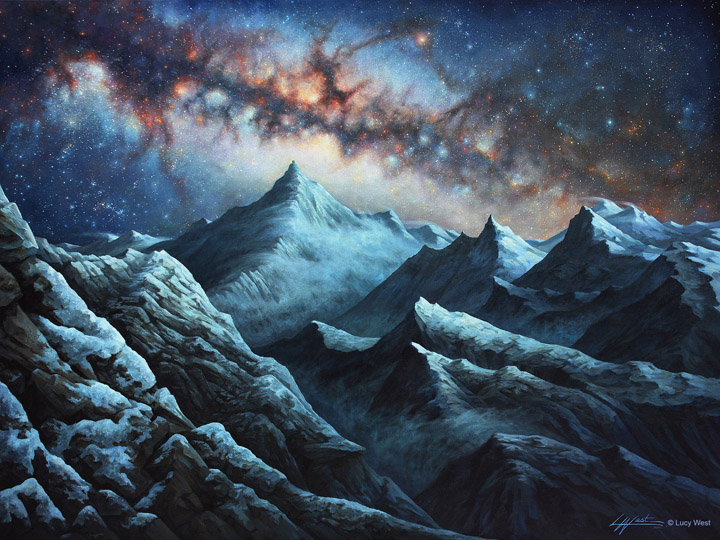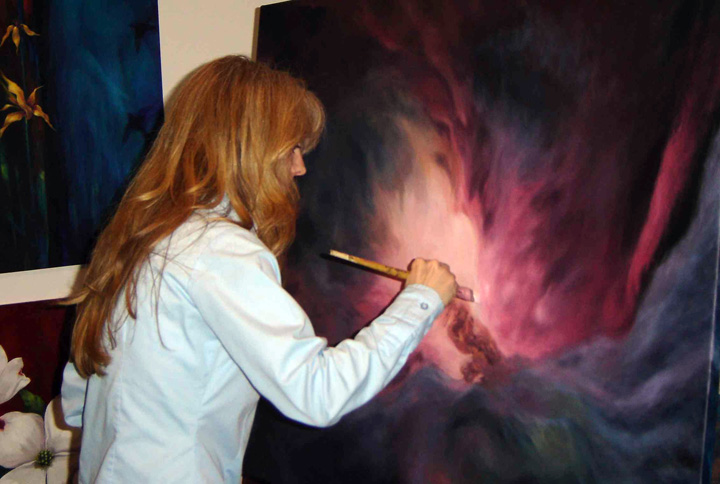- Published: Saturday, August 13 2016 02:58
Interview with the Space Artist

“Tapestry of Time”
Q1: I see you work in acrylics as your most common medium. Many artists today have gone the “digital” route. What is it that you find so interesting about using physical paints on canvas?
I appreciate the organics and alchemy of mixing paints, and the interplay between me, the brushes, paints and canvas. I don’t experience the same immersion through digital medium. Painting is all very tactile and engaging, and at times its visceral or emotional. Also, its physical. Because I work large scale I rely on my entire body to participate in painting, and often find myself reflecting on my childhood training in ballet that taught me grace, balance and patience. I experience this through the long graceful sweeps of my arms as I softly blend large blocks of color, and the way my body leans into the strokes and holds the position even when I’m fatigued; the intentional rhythmic flick of my wrist in short strong strokes and how that reverberates through me and cause the canvas to bounce back at me; the way I glide back and forth away from the canvas to get a wider perspective and come back in to work detail; how I pivot and balance from one foot to the other when reaching to dab in detail; the way new ideas start to morph in front of me on the canvas and force me to keep up with the pace.
For me, each new project is similar to dancing with a new partner for the first time and learning how to gracefully move along with them until it becomes a natural ebb and flow of mutual efforts. By the time a painting is complete I am familiar with every little thing about that canvas and how I have transformed it and how it has transformed me. When I stand back and inspect the finished work, I feel a similar familiarity to what a long-time couple might experience and all the subtle, wordless nuances that forge between them through interacting over a long period of time.
Another thing I appreciate about traditional painting is that there is no “undo” command or layers that can be deleted. Once you put paint to canvas you’re committed to every action you make until the painting is complete. That can be thrillingly intimidating! If painting has taught me anything, it has taught me to commit to my decisions, be courageous and true in my intensions, recognize the story beyond my story, communicate with sincerity and trust the process.
Sometimes the essential part of painting is when mistakes occur. Troubleshooting ensues and I have to engineer a way past the error. That sort of challenge is invigorating and instructive. Usually that’s when an unexpected direction develops and the painting turns out to be something all together different than what I initially thought it was going to be, and even turns out better! I welcome mistakes - they are always excellent teachers.

“Studio5”
Q2: You mentioned that you do a great deal of research when planning a painting. Could you walk us through your process and tell us where you get your research data from?
For referenced pieces of actual objects like M101, I’ll first search images online and local library. Of course the Hubble Space Telescope has provided an incredible library of beautiful images to pull reference from but I also like to study other light wavelength references such as infrared and X-ray as produced by the Spitzer Space Telescope and the Chandra X-ray Observatory. These light wavelengths reveal properties and dimensionality of the object that we can’t see in visible-light. I blow these images up and study the dynamics until I recognize what I call important happenings and landmarks that make the object unique.
Then I research published papers, articles and books from professional scientists and astronomers who are kind enough to share their material with me. Also I find articles online. If something unique tickles my interest from these resources I’ll research deeper into that vein. Sometimes I get stuck and need a sounding board to bounce ideas off of, so I’ll contact the scientists involved in the research or the people processing the images I’m using as reference. I also talk to my fellow IAAA members. And finally but not least, my incredibly smart husband is a great sounding board whom has the unusual advantage of knowing my work very well and so his input can be the most valuable at times.
Sometimes I’ll go to a physical location that may bear similarities to an otherworldly planetary landscape that I’m interested in illustrating, such as Meteor Crater in Arizona or Carters of the Moon in Idaho. Being on location like that can reveal elements I may not have considered.
Observatories and planetariums are wonderful places to visit when I’m researching astronomical objects. Another thing I like to do is investigate historical information surrounding the subject, how it was understood say 100 years ago or 2,000 years ago, and how that understanding has changed throughout history. This reveals the human effort in exploring the unknown, and that is important to me because I wish to communicate the human experience in my work.
Once I have the collected material at my fingertips I tack it up around my easel and on the walls of my studio for reference and inspiration. I even fill my laptop desktop with various images so that I can see them every day. Basically, I saturate my life with the subject until my project is complete!

“Pinwheel Galaxy M101”
Q3: You are a member of the International Association of Astronomical Artists. How long have you been a member and what drew you to join that group?
I’ve known about the association for a number of years and have admired the work and accomplishments of its members from afar. The careers of many of the members are quite outstanding and have motivated me to push forward even when things could be difficult. To my good fortune, I was approached by a member in 2011 who suggested I submit my work for application. I can’t tell you how excited and honored I was when accepted. It was only natural to want to be a part of the group that felt like my tribe. Before I became a member of IAAA my experience as an artist was strictly solo. I’m self taught, and have never joined other artist groups or attended workshops or sought training. So, being part of an artistic enclave of this caliber is an altogether new and superb experience!
Q4: Every artist has a personal favorite work of their own. Which of your works is your favorite and why?
“Origins”! “Origins” contains so many elements that have enhanced my life and inspire me to do the work I do: science, particle physics, astronomy, human history, human nature, exploration of the cosmos, creation, envisioning future explorations out into the great unknown. It’s a piece that seemed to just show up in my studio one day. Some works are like that, where the artist feels less like the creator and more like the catalyst being moved by an outside source.

Image: “Origins”
Q5: What other artists do you like?
As a young artist my mentors were William Blake, Van Gogh, William Turner, Monet, O’Keeffe, Dali, Klimt, Pollock, Rodin, da Vinci and Bernini. Looking back I see that I was drawn to artists who were breaking out of traditional methodologies and forging new frontiers in art. I still see their influence showing up in my work.
Today many of my favorite artists are my fellow IAAA members - a list that would fill another page here so I will choose just a handful of what I call ‘heavy hitters’: Alan Bean, Robert McCall, Ron Miller, Pamela Lee, Marilynn Flynn, David Hardy, Don Davis, Kim Poor, Michael Carroll, William Hartmann. And these artists continue to inspire and teach me: Chesley Bonestell, Paul Cali, Ludeke Pesek, Lucien Rudaux, Étienne Léopold Trouvelot, W. Kranz.








Comments